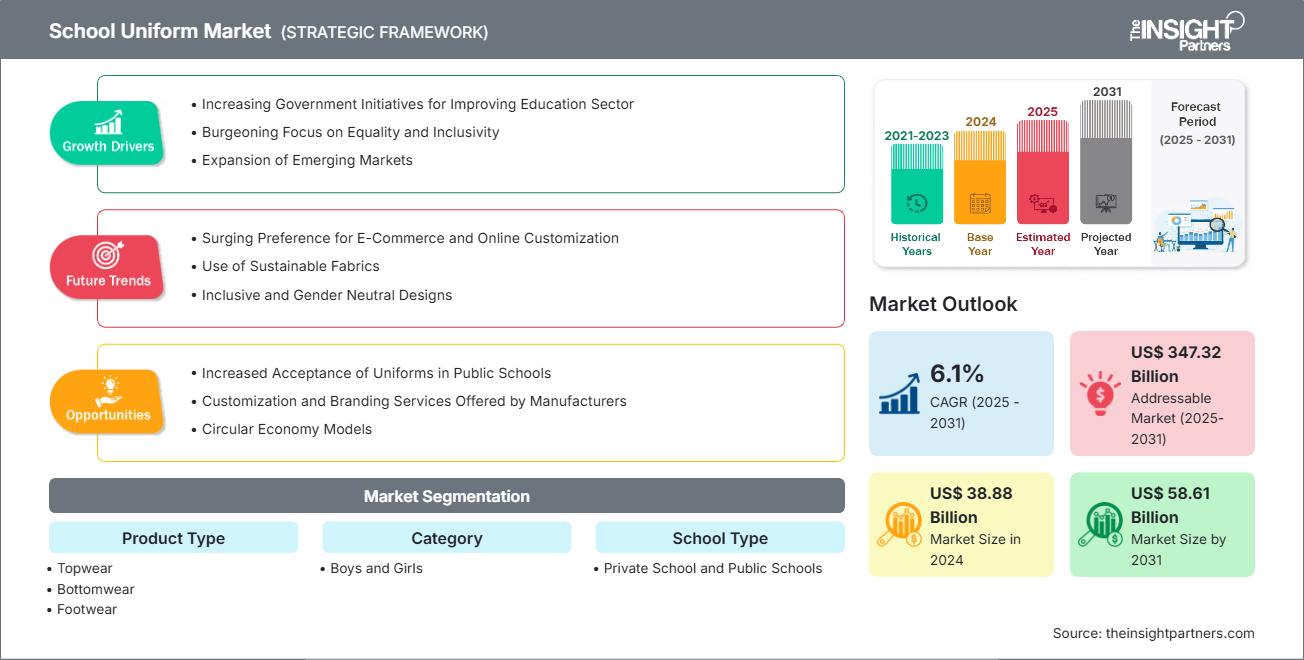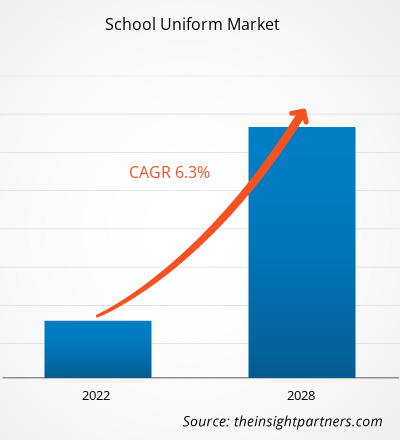교복 시장 규모는 2024년 388억 8천만 달러에서 2031년 586억 1천만 달러로 성장할 것으로 전망됩니다. 이 시장은 2025년부터 2031년까지 연평균 성장률 6.1%를 기록할 것으로 예상됩니다.
교복 시장 분석
글로벌 교복 시장은 학생 수 증가, 정부 정책 변화, 그리고 표준화된 학생 복장에 대한 요구로 형성되고 있습니다. 특히 아시아 태평양 지역의 교육 기관 확장과 공립 및 사립 학교의 교복 도입 확대는 교복 수요를 촉진하고 있습니다. 규율과 단결을 중시하는 문화적, 제도적 흐름이 지속됨에 따라, 제조업체들은 편안함, 포용성, 그리고 지속 가능한 소재에 집중하고 있습니다. 디지털 리테일 솔루션과 맞춤형 서비스 또한 구매 경험을 혁신하여 시장 성장과 변화를 가속화하고 있습니다.
교복 시장 개요
교복 시장은 변화하는 교육 방식과 사회적 우선순위에 발맞춰 끊임없이 발전하고 있습니다. 특히 교복이 학교 문화에 필수적인 지역 사회에서 학교 교육의 확산이 교복 시장의 성장을 촉진하고 있습니다. 복장 규정의 도입은 평등과 규율을 뒷받침하여 교복 수요를 촉진합니다. 한편, 제조업체들은 스타일, 편안함, 그리고 환경적 선호도의 변화에 적응하고 있습니다. 향상된 온라인 쇼핑 옵션과 맞춤화 확대는 가정과 학교가 교복 공급업체와 관계를 맺는 방식을 재정의하며, 지속적인 시장 발전을 뒷받침하고 있습니다.
이 보고서의 일부 또는 국가 수준 분석, Excel 데이터 팩을 포함하여 모든 보고서에 대한 사용자 정의를 무료로 받을 수 있으며, 신생 기업 및 대학을 위한 훌륭한 혜택과 할인도 이용할 수 있습니다.
교복 시장: 전략적 통찰력

-
이 보고서에서 주요 시장 동향을 알아보세요.이 무료 샘플에는 시장 동향부터 추정치 및 예측까지 다양한 데이터 분석이 포함됩니다.
교복 시장 성장 동력과 기회
시장 동인:
-
교육을 위한 정부 이니셔티브 강화:
교육 확대를 위한 정부 정책으로 학교 등록률이 높아지고 교복 착용이 의무화되면서 수요가 직접적으로 증가했습니다. -
개발도상국의 학교 등록률 증가:
특히 인구가 많은 인도나 중국 등 개발도상국에서 학교 수와 학생 수가 늘어나면서 교복 시장이 확대되고 있습니다. -
주요 지역의 인구 증가 가속화:
아시아 태평양 지역 등지의 급속한 인구 증가로 인해 특히 초등 및 중등 교육 수준에서 교복에 대한 수요가 꾸준히 유지되고 있습니다. -
중산층 가정의 가처분 소득 증가:
신흥 경제권에서는 소득 수준이 향상되면서 가족들이 브랜드가 붙은 프리미엄 품질의 유니폼에 투자할 수 있게 되었고, 이로 인해 시장 성장이 더욱 촉진되었습니다. -
유니폼 디자인의 지속 가능성과 혁신 증진
내구성, 편안함, 얼룩 방지 등의 기술적으로 강화된 원단과 친환경 소재에 대한 선호도가 높아지면서 소비자의 기대치가 바뀌고 제조업체에게는 새로운 기회가 창출되고 있습니다.
시장 기회:
-
신흥 시장에서의 입지 확대:
아시아 태평양, 아프리카, 라틴 아메리카 지역에서는 급속한 도시화, 가처분소득 증가, 인구 증가로 인해 학교 등록률이 증가하고 교복에 대한 수요가 급증하고 있습니다. -
전자상거래 및 직접 소비자 채널의 성장 가속화:
온라인 소매 및 DTC(Direct to Consumer) 판매 채널로의 전환은 시장을 획기적으로 변화시켰습니다. 이제 기업은 더 다양한 선택지, 간편한 맞춤 설정, 가격 투명성, 그리고 편의성을 통해 부모에게 직접 다가갈 수 있게 되었으며, 이는 기존 지역 오프라인 공급업체의 독점적 지위를 깨고 신규 진입 기업과 틈새 브랜드의 시장 진출을 가능하게 했습니다. -
제품 혁신 및 맞춤화 발전:
맞춤형 핏, 스타일, 학교 브랜딩에 대한 소비자 수요 증가로 차별화의 기회가 생겨 프리미엄 가격 책정 전략이 뒷받침됩니다. -
대량 계약 및 기관 판매 확보:
학교와 교육 기관들이 장기 계약을 체결하는 경우가 점차 늘어나고 있으며, 이는 공급업체들이 안정적이고 대량의 계약을 확보할 수 있는 기회를 제공합니다. 이러한 기관 간 거래는 인구 밀도가 높은 지역과 정부에서 의무화한 교복 프로그램에서 특히 중요합니다. -
초등 및 중등 교육 부문을 타겟으로 함:
교복에 대한 수요는 초등학생과 중등학생 사이에서 특히 강한데, 이는 이 연령대의 학생들이 대학에 비해 등록률이 높고 교복 착용 의무가 더 널리 적용되기 때문입니다.
교복 시장 보고서 세분화 분석
교복 시장은 시장 운영 방식, 성장 잠재력, 그리고 최신 트렌드를 더욱 명확하게 보여주기 위해 여러 부문으로 구분됩니다. 대부분의 업계 보고서에서 사용되는 표준 세분화 방식은 다음과 같습니다.
제품 유형별:
-
상의:
셔츠, 블라우스, 스웨터, 재킷 등 상체에 입는 교복 의류입니다. -
하의:
바지, 치마, 반바지, 앞치마 등 하체에 입는 제복 품목입니다. -
신발류:
신발, 샌들 또는 학교에서 사용하도록 특별히 디자인된 다른 유형의 신발은 교복의 일부입니다. -
기타:
교복과 관련된 추가 액세서리나 품목으로는 넥타이, 벨트, 양말, 모자, 스카프 등이 있습니다.
카테고리별:
-
소년들:
교복 제품은 남학생을 위해 특별히 디자인되고, 사이즈가 정해지고, 스타일이 정해졌습니다. -
여자아이들:
교복 제품은 여학생을 위해 특별히 디자인되고, 사이즈와 스타일이 정해져 있습니다.
학교 유형별:
- 사립학교
- 공립학교
유통 채널별:
- 슈퍼마켓과 하이퍼마켓
- 전문점
- 온라인 소매
- 기타
지리별:
- 북아메리카
- 유럽
- 아시아 태평양
- 중동 및 아프리카
- 남미 및 중미
아시아 태평양 지역의 교복 시장은 가장 빠르게 성장할 것으로 예상됩니다. 교육 접근성이 확대됨에 따라 아시아 태평양 지역의 교복 시장은 지역 교육 경험에 여전히 중요한 역할을 하고 있습니다.
교복 시장 지역별 통찰력
The Insight Partners의 분석가들은 예측 기간 동안 교복 시장에 영향을 미치는 지역별 동향과 요인들을 면밀히 분석했습니다. 이 섹션에서는 북미, 유럽, 아시아 태평양, 중동 및 아프리카, 그리고 중남미 지역의 교복 시장 세분화 및 지역별 분포도 살펴봅니다.
교복 시장 보고서 범위
| 보고서 속성 | 세부 |
|---|---|
| 2024년 시장 규모 | 388억 8천만 달러 |
| 2031년까지 시장 규모 | 586억 1천만 달러 |
| 글로벌 CAGR(2025~2031년) | 6.1% |
| 역사적 데이터 | 2021-2023 |
| 예측 기간 | 2025-2031 |
| 다루는 세그먼트 |
제품 유형별
|
| 포함된 지역 및 국가 |
북아메리카
|
| 시장 선도 기업 및 주요 회사 프로필 |
|
교복 시장 참여자 밀도: 비즈니스 역학에 미치는 영향 이해
교복 시장은 소비자 선호도 변화, 기술 발전, 그리고 제품의 장점에 대한 인식 제고 등의 요인으로 최종 사용자 수요가 증가하면서 빠르게 성장하고 있습니다. 수요가 증가함에 따라 기업들은 제품 라인업을 확장하고, 소비자 니즈를 충족하기 위한 혁신을 추진하며, 새로운 트렌드를 적극 활용하고 있으며, 이는 시장 성장을 더욱 가속화하고 있습니다.

- 학교 교복 시장 주요 주요 업체 개요를 확인하세요
지역별 교복 시장 점유율 분석
아시아 태평양 지역은 향후 몇 년 동안 가장 빠른 성장을 보일 것으로 예상됩니다. 라틴 아메리카, 중동, 아프리카의 신흥 시장 또한 교복 공급업체들이 확장할 수 있는 많은 미개척 기회를 보유하고 있습니다.
교복 시장은 학교 등록 학생 수 증가, 교육 부문에 대한 정부 및 민간 투자 증가, 그리고 가처분소득 증가로 인해 지역별로 성장세가 다릅니다. 아래는 지역별 시장 점유율과 추세를 요약한 것입니다.
1. 북미
-
시장 점유율:
매년 시장 점유율이 증가하는 가장 빠르게 성장하는 지역 -
주요 동인:
- 표준화된 복장 규정의 채택 증가
- 학생 간 규율, 평등, 동료 압력 감소에 중점을 둡니다.
- 특히 도시 학교에서 교복 도입을 장려하는 정부 지원 및 정책
-
트렌드:
교복을 온라인으로 판매하는 시장이 성장하면서 학교와 학부모에게 더욱 편리하고 맞춤화된 옵션을 제공하고 있습니다.
2. 유럽
-
시장 점유율:
교복을 통해 평등에 대한 인식이 높아짐에 따라 상당한 점유율을 확보 -
주요 동인:
- 공립학교에서 표준화된 복장 규정 채택 증가
- 교복 정책을 통해 평등, 규율, 학교 정체성을 증진하는 데 중점을 둡니다.
- 정부 재정 지원으로 저소득 가정 교복 구매 가능해져
-
트렌드:
시장은 지속 가능한 원단과 온라인 맞춤형으로 이동하고 있으며, 점점 더 많은 학교에서 포괄적인 디자인과 맞춤형 핏을 선택하고 있습니다.
3. 아시아 태평양
-
시장 점유율:
글로벌 시장의 상당 부분을 차지합니다 -
주요 동인:
- 지역 전체 학교에서 의무 교복 정책의 보급
- 인도와 중국 등의 나라에서는 학생 인구가 많고 계속 증가하고 있습니다.
- 교육 인프라 확대 및 공교육에 대한 정부 지원 확대
-
트렌드:
저렴하면서도 내구성이 뛰어난 유니폼과 친환경 소재에 대한 시장이 확대되고 있으며, 제품 품질과 기술 혁신에 대한 투자도 늘어나고 있습니다.
4. 중동 및 아프리카
-
시장 점유율:
꾸준한 성장으로 성장하는 시장 -
주요 동인:
- 특히 사립 및 국제 학교에서 교복 착용이 증가하고 있습니다.
- 정부 주도의 이니셔티브와 스포츠 및 과외 활동에 대한 강조
-
트렌드:
온라인 소매점과 전문 매장이 점점 더 중요해지고 있으며, 기술 혁신과 새로운 제품 기능이 시장 확장에 중요합니다.
5. 남미 및 중미
-
시장 점유율:
작지만 빠르게 성장하고 있습니다 -
주요 동인:
- 교육기관 건설 및 투자 확대
- 규율 있는 환경을 조성하는 데 있어 교복의 이점에 대한 인식이 높아지고 있습니다.
-
트렌드:
이 지역은 정책 변화와 사립 교육 부문의 확대에 힘입어 교복 도입이 꾸준히 증가하고 있습니다.
교복 시장 참여자 밀도: 비즈니스 역학에 미치는 영향 이해
높은 시장 밀도와 경쟁
Dean Clothing Ltd, Gogna Schoolwear and Sports Ltd, Trutex Limited, John Lewis plc, Elder Manufacturing Company, Inc.와 같은 기존 업체가 있어 경쟁이 치열합니다. The Uniform Company(아시아), Flash Uniforms(아시아 태평양), Alinta(아시아 태평양)와 같은 지역 및 틈새 시장 공급업체도 다양한 지역에서 경쟁 환경을 더욱 강화하고 있습니다.
이러한 높은 수준의 경쟁으로 인해 기업은 다음과 같은 서비스를 제공하여 두각을 나타내야 합니다.
- 직물 기술의 혁신
- 편안함과 핏에 중점을 두다
- 지속 가능성에 대한 수요 증가
- 맞춤 설정 및 개인화
기회와 전략적 움직임
- 직물 재활용업체, 유통업체 및 기타 원자재 공급업체와 강력한 파트너십을 구축하는 것이 필수적이 되고 있습니다.
- 기업들은 지속 가능한 제품을 제공하기 위해 후방통합을 모색하고 있습니다.
- 시장 선도업체는 온라인 주문, 사이즈 맞춤 제작, 재고 관리를 위한 디지털 플랫폼에 투자하여 물류를 간소화하고 고객 경험을 개선합니다.
교복 시장에서 활동하는 주요 회사는 다음과 같습니다.
- 프렌치 토스트(미국)
- 엘더 제조 회사(미국)
- Winterbottom's Schoolwear(영국)
- 윌리엄슨-디키 제조 회사(미국)
- Trutex Limited(영국)
- 존 루이스 plc(영국)
- 유니폼 회사(인도)
- 프라이리치 교복(미국)
- 플래시 유니폼(호주)
- 알린타(호주)
- Dean Clothing Ltd(영국)
- Gogna Schoolwear and Sports Ltd(영국)
- 브리게이드 클로딩 유한회사(영국)
- 페리 유니폼(Uniform Schoolwear Ltd.)(영국)
- 제코 리미티드(영국)
면책 조항: 위에 나열된 회사는 특정 순서에 따라 순위가 매겨지지 않았습니다.
연구 과정에서 분석된 다른 회사:
- 리알푸르 유니폼(인도)
- DUC GIANG CORPORATION DUCARGO (베트남)
- Dong Bich Company Limited (베트남)
- C Lai World(인도)
- 샬가르 양말(인도)
- 광저우 시레이 의류 유한회사(중국)
- Chasvik Enterprises Pvt Ltd(인도)
- 골드텍스(캐나다)
- 모든 유니폼 착용(미국)
- 랜즈 엔드(미국)
- 킹스 스포츠(인도)
- 파브리스타 의류(인도)
- 프로모션 유니폼(인도)
- Fa Uniforms (인도)
- KNF 유니폼(인도)
교복 시장 뉴스 및 최근 동향
-
클락스, 새로운 교복 컬렉션 출시
2025년 7월, 새로운 Clarks 브랜드 학교복 제품군에는 4~11세 어린이를 대상으로 디자인된 스커트, 바지, 셔츠, 점퍼가 포함됩니다. -
Target, 개학 시즌 및 대학 시즌 시작에 맞춰 2024년 학용품 가격 동결
타겟(Target)은 2024년 주요 신학기 용품 가격을 유지한다고 발표했습니다. 인기 상품인 20가지 필수품 목록(총 20달러 미만)과 작년에 가장 많이 팔린 5달러짜리 백팩을 포함합니다. 이는 학용품, 교실 필수품, 기숙사 인테리어, 트렌디한 의류 전반에 걸쳐 가치, 스타일, 편의성을 최우선으로 하는 타겟의 신학기 및 대학 시즌 전략의 일환입니다. 또한, 학생 및 교사 할인 혜택이 다시 돌아왔으며, 7월 6일부터 12일까지 고객들에게 큰 호응을 얻은 세일 행사인 '타겟 서클 위크(Target Circle Week)'를 통해 학용품, 전자제품 등을 더욱 저렴하게 구매할 수 있다고 발표했습니다. -
Schoolblazer, 신뢰할 수 있는 파트너 프로그램 출시
스쿨블레이저(Schoolblazer)는 젊은 브랜드의 스포츠 참여 증진을 지원하는 새로운 제휴 프로그램인 '신뢰할 수 있는 파트너(Trusted Partners)' 프로그램을 출범했습니다. 선정된 세 브랜드에는 레존 할로스(Rezon Halos) 헤드밴드, 페베(PeBe) 스포츠 브라, 닉스 바디(NIXI Body) 속옷이 포함됩니다. -
Elaghmore, Trutex Limited 지분 인수
영국 사모펀드 엘라모어(Elaghmore)가 영국에서 가장 오래되고 유명한 고급 교복 생산업체 중 하나인 트루텍스 리미티드(Trutex Limited, 이하 "트루텍스")의 지분 42%를 인수했습니다. 엘라모어는 지분 인수 외에도 트루텍스에 320만 달러(250만 파운드)의 신규 자본을 투자할 예정입니다. 동시에 트루텍스는 아우렐리우스 파이낸스 컴퍼니(AURELIUS Finance Company)와 2,360만 달러(1,850만 파운드) 규모의 신규 재융자 계약을 체결했습니다. -
Limitless, The Well HQ와 협력해 여성 운동선수 지원
Limitless는 The Well HQ의 액티브 파트너가 되었다고 발표했습니다. The Well HQ는 영국 최고의 여성 운동선수 전문 기업입니다. 코치, 일반의, 과학자로 활동하는 바즈, 벨라, 에마가 설립한 이 회사는 수십 년 동안 여성들과 함께 운동선수들을 훈련시키고, 바디 리터러시를 가르치고, 발전을 가로막는 금기 사항들을 깨뜨리는 등 독립적으로 활동해 왔습니다. 2018년, 여성들이 삶의 모든 측면에서 성공하는 데 필요한 지식, 자원, 그리고 지원을 제공한다는 사명을 가지고 힘을 합쳤습니다.
교복 시장 보고서 범위 및 성과물
"교복 시장 규모 및 예측(2021~2031)" 보고서는 다음 분야를 포괄하는 시장에 대한 자세한 분석을 제공합니다.
- 범위에 포함된 모든 주요 시장 부문에 대한 글로벌, 지역 및 국가 수준의 학교 교복 시장 규모 및 예측
- 교복 시장 동향 및 운전자, 제지 장치 및 주요 기회와 같은 시장 역학
- 자세한 포터의 5가지 힘 분석 및 SWOT 분석
- 주요 시장 동향, 글로벌 및 지역 프레임워크, 주요 참여자, 규정 및 최근 시장 개발을 다루는 학교 교복 시장 분석
- 시장 집중도, 히트맵 분석, 주요 업체 및 학교 교복 시장의 최근 동향을 다루는 산업 환경 및 경쟁 분석
- 자세한 회사 프로필
- 과거 분석(2년), 기준 연도, CAGR을 포함한 예측(7년)
- PEST 및 SWOT 분석
- 시장 규모 가치/거래량 - 글로벌, 지역, 국가
- 산업 및 경쟁 환경
- Excel 데이터세트
최근 보고서
사용 후기
구매 이유
- 정보에 기반한 의사 결정
- 시장 역학 이해
- 경쟁 분석
- 고객 인사이트
- 시장 예측
- 위험 완화
- 전략 기획
- 투자 타당성 분석
- 신흥 시장 파악
- 마케팅 전략 강화
- 운영 효율성 향상
- 규제 동향에 발맞춰 대응






















 무료 샘플 받기 - 교복 시장
무료 샘플 받기 - 교복 시장